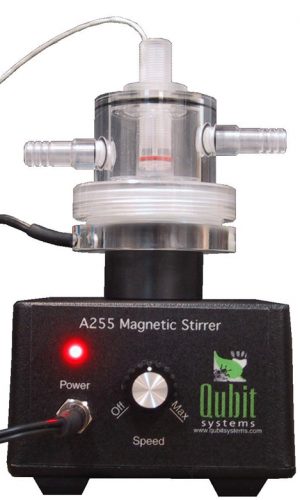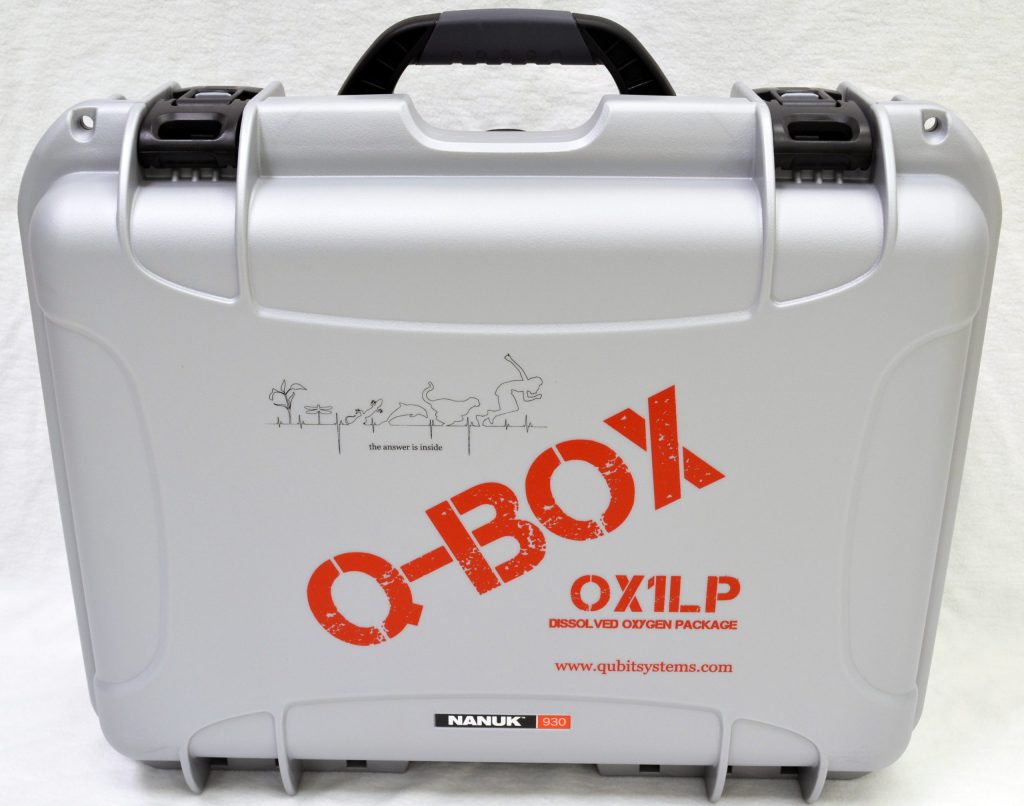The OX1LP Dissolved Oxygen Packages are based on the use of polarographic dissolved oxygen electrodes and may be used to measure photosynthesis and/or respiration in the aqueous phase, using suspensions of plant cells, animals, organelles (chloroplasts and mitochondria) and algae. These packages may also be used to monitor chemical and biochemical reactions that either produce or consume O2 in the aqueous phase. The Dissolved Oxygen Package comes complete with all of the instruments, accessories, software, data acquisition interface and manuals for the instructor and the student.
The OX1LP Dissolved Oxygen Packages are available with DO electrodes of different volumes from 100ul (flow-through) to 50 ml. The O2 electrode within the water-jacketed cuvette may be used for measurements of O2 consumption (or production) by biological samples or enzymatic reactions. Calibration is a simple 2-point process, and all the required accessories for calibration are supplied as part of the package.
The Dissolved Oxygen Package provides excellent accuracy and a resolution of 0.03% O2 (where air saturated water = 100%). Dissolved O2 values may be expressed in any desired units (mg/L; % dissolved O2; ppm etc) based on a simple calibration procedure. The water jacket allows calibrations and experiments to be carried out at the same temperature, or a simple temperature correction can be made in software for measurements made at different temperatures.
- Polarographic oxygen electrode system
- Different volume cuvette chambers available (1, 2.5, 4, 6, 30, 50ml)
- Water-jacketed cuvette allows temperature control with an optional water bath
- Includes all the accessories
- Easy assembly and calibration
- Algal photosynthesis and respiration
- Bacterial respiration
- Respiration of small aquatic animals
- Aquatic insects and larvae respiration
- Mitochondrial respiration
- Chloroplast O2 production
- Cell suspension respiration
- Plant cells suspension photosynthesis
- Enzymatic Reactions that consume or produce O2
- Dissolved Oxygen Cuvette Electrode (1, 2.5, 4, 6, 30, 50 mL)
- A231 Cuvette Electrode Amplifier
- A255 Magnetic Stirrer
- A135 Stir Bar (2) and O-Ring (2)
- A131 KCl Filling Solution
- A136 Membrane Material and Filter Paper
- 10 ft Excelon Tubing for the Water Jacket
- C610 LabQuest Mini Data Interface
- C901 Logger Pro Software
- C404 Customized Setup Software
- Instructor’s and Student’s Manuals (include experiments)
Optional Components:
- Syringes for addition of metabolites to cuvette; (A141) 10µL, (A143) 50µL, (A145) 100µL
- S172 Thermistor for measurements of sample temperature (not available for 1ml cuvette)
- A113 calibrated LED light source
- Q-Box rugged case for storage and transport of all components
Examples of Experiments for OX1LP packages:
- Measurement of Aquatic Photosynthetic O2 Evolution
- Effect of Inhibitors on Mitochondrial Electron Transport
- Analysis of Light-dependent Chloroplast Electron Transport
- Effects of Temperature on O2 Uptake by Aquatic Animals
- Kinetics of O2-consuming Enzymes
- Tomasch J et al. (2024) A photoheterotrophic bacterium from Iceland has adapted its photosynthetic machinery to the long days of polar summer. Microbial Ecology, ASM Journal/mSystems 9. https://doi.org/10.1128/msystems.01311-23
- Sittisaree W et al. (2024) Effect of NH4CL supplementation on growth, photosynthesis, and triacylglycerol content in Chamydomonas reinhardtii under mixotrophic cultivation. Journal of applied Microbiology 135 https://doi.org/10.1093/jambio/lxae233
- Heithoff DM et al. (2023) A broad spectrum synthetic antibiotic that does not evoke bacterial resistance. The Lancet 89: 104461 :https://doi.org/10.1016/j.ebiom.2023.104461
- Chambonniere P et al. (2022) Photosynthetic carbon uptake correlates with cell protein content during lipid accumulation in the microalga Chlorella vulgaris NIES 227. Fermentation 8(11):614 https://doi.org/10.3390/fermentation8110614
- Koblizek M et al (2020) Utilization of Light energy in phototropic Gemmatimonadetes. Journal of Photochemistyr and Photobiology B 213: 112085 https://doi.org/10.1016/j.jphotobiol.2020.112085
- Nair P, Huertas M, Nowlin WH (2020) Metabolic responses to long-term food deprivation in subterranean and surface amphipods. Subterranean Biology 33: 1-15 https://digital.library.txstate.edu/handle/10877/9805
- Henry EF, MacCormack TJ (2018) Taurine protects cardiac contractility in killifish, Fundulus heteroclitus, by enhancing sarcoplasmic reticular Ca2+ cycling. Journal of Comparative Physiology B 188:89-99 https://link.springer.com/article/10.1007/s00360-017-1107-4
- Lamarre SG et al. (2019) Interrelationship Between Contractility, Protein Synthesis and Metabolism in Mantle of Juvenile Cuttlefish (Sepia officinalis). Frontiers in Physiology V10, 1-14 (doi: 10.3389/fphys.2019.01051)
- Sirikhachornkit et al. (2016) Increasing the Triacylglycerol Content in Dunaliella tertiolecta through Isolation of Starch-Deficient Mutants. J. Microbiol. Biotechnol. 26(5), 854–866
- Croston, Tara L., et al. (2014) Functional deficiencies of subsarcolemmal mitochondria in the type 2 diabetic human heart. American Journal of Physiology-Heart and Circulatory Physiology 307.1 H54-H65
- Sussarellu, Rossana, et al. (2013) Rapid mitochondrial adjustments in response to short-term hypoxia and re-oxygenation in the Pacific oyster, Crassostrea gigas.” The Journal of Experimental Biology 216.9 1561-1569
- Dickinson GH et al. (2013) Environmental salinity modulates the effects of elevated CO2 levels on juvenile hard-shell clams, Mercenaria mercenaria. The Journal of experimental biology 216.14 2607-2618.
- Bauer I and Kappler A (2009) Rates and Extent of Reduction of Fe(III) Compounds and O2 by Humic Substances. Environ. Sci. Technol. Vol 43, Number 13, p4902–4908
- Mosher CM et al. (2008) Functional Analysis of Phenylalanine Residues in the Active Site of Cytochrome P450 2C9. Biochemistry Vol 47, Number 45, p11725–11734
- Mendelsohn BA et al. (2008).The zebrafish embryo as a dynamic model of anoxia tolerance. Developmental Dynamics Vol 237, Issue 7, p1780–1788
- Mendelsohn BA and Gitlin JD (2008) Coordination of development and metabolism in the pre-midblastula transition zebrafish embryo. Developmental Dynamics Vol 237, Issue 7, p1789–1798.
- Johnson EA, Rosenberg J, McCarty RE. (2007) Expression by Chlamydomonas reinhardtii of a chloroplast ATP synthease with polyhistidine-tagged beta subunits. Biochimica et Biophysica Acta 1767:374-380
- Johnson E A. (2008) Altered expression of the chloroplasts ATP synthase through site-directed mutagenesis inChlamydamonas Reinhardtii. Photosynth Res vol 96:153-162
- Locuson CW, Gannett PM and Tracy TS (2006) Heteroactivator effects on the coupling and spin state equilibrium of CYP2C9. Archives of Biochemistry and Biophysics Vol 449, Issues 1-2, p115-129

The following OX1LP packages are available depending on the volume of the DO electrode required:
- OX1LP-1 (1ml perspex)
- OX1LP-2.5 (2.5ml glass or perspex)
- OX1LP-4 (4ml perspex)
- OX1LP-6 (6ml glass)
- OX1LP-30 (30ml perspex)
- OX1LP-50 (50ml perspex or glass)
Testimonial
“I have tested my new Qubit system with isolated oyster mitochondria, and was extremely pleased with the results. I can’t believe I was suffering for the whole year with my old chamber. I have tried three different systems based on Clarke-type electrodes including this one, and this is by far the most convenient for use with small sample volumes and gives a very clean, repeatable trace with the best signal to noise ratio I ever had with micro-chambers.”
Dr. Inna Sokolova, Assistant Professor, Biology Department, University of North Carolina at Charlotte




